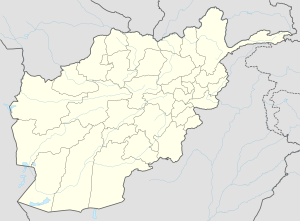City in Daikundi, Afghanistan
Nili (Dari : نیلی ) is a city in central Afghanistan , serving as the capital of Daikundi Province since 2004.[ 2] road network with Bamyan in neighboring Bamyan Province to the northeast and Tarinkot in Uruzgan Province to the south.[ 3]
Nili has a total land area of 9,022 ha (22,290 acres),[ 4] [ 1] Hazaras , and others being the minority.[ 5]
The city, which has over 2,000 houses and businesses,[ 4] Nili District and the Hazarajat region.[ 2] above sea level . The Nili Airport is located a few miles away from the town center known as Gul-e-Badam Square (Almond Blossom Square ).
Nili is an urban village in central Afghanistan in which the majority of the land is not built-up.[ 4] [ 6] [ 4] [ 4]
History
Azra Jafari , former mayor of Nili and the first female mayor in Afghanistan (April 15, 2012)Nili became the capital of Daikundi Province in March of 2004.[ 2] town within the pre-2004 larger Uruzgan Province . Due to its geographical inaccessibility and harsh winter, it was not until April 2007 that the United Nations opened a UNAMA office.
In December 2008, then-President Hamid Karzai selected Azra Jafari as mayor of Nili, which made her Afghanistan's first female mayor.
On 14 August 2021, Nili was seized by Taliban forces, becoming the twenty-fourth provincial capital to be captured by them as part of the wider 2021 Taliban offensive .[ 7] [ 8]
Climate
Nili has a hot-summer humid continental climate (Dsa) in the Köppen climate classification , with dry summers and cold, snowy winters. Precipitation mostly falls in spring and winter.
Climate data for Nili, Daikundi Province
Month
Jan
Feb
Mar
Apr
May
Jun
Jul
Aug
Sep
Oct
Nov
Dec
Year
Record high °C (°F)
15
16
22
26
32
37
38.5
37
34
28
24.0
16.5
38.5
Mean daily maximum °C (°F)
0
0
8.0
17
24
30
32
31
27
20
12
5
17.2
Mean daily minimum °C (°F)
−10.0
−8.0
−2.0
5
11
17
19
18
14
8
1.0
−6
5.6
Record low °C (°F)
−19.0
−16.0
−10.0
−2
4.0
7.0
8.0
6.0
−1.0
−2.0
−7.0
−14.0
−19.0
Average precipitation mm (inches)
67
87
95.0
53
17.0
2.0
2.0
2.0
0.0
6.0
33.0
40
404
Average precipitation days (≥ 1.0 mm)
10
12
13
13
8
1.0
0.5
0.5
0.1
2
7
7.6
74.7
Average snowy days
10
10
6
0
0.0
0.0
0.0
0.0
0.0
0.0
2
6
34
Source 1: meteoblue[ 9]
Source 2: meteoblue[ 10]
Climate data for Nili, Daikundi Province
Month
Jan
Feb
Mar
Apr
May
Jun
Jul
Aug
Sep
Oct
Nov
Dec
Year
Mean daily maximum °C (°F)
−1.7
0.0
6.1
15.6
21.7
27.8
31.1
30.0
26.1
18.9
9.4
3.3
15.7
Daily mean °C (°F)
−6.9
−4.7
1.4
9.8
15.6
21.4
24.7
23.4
19.2
12.5
3.9
−2.5
9.8
Mean daily minimum °C (°F)
−12.2
−9.4
−3.3
3.9
9.4
15.0
18.3
16.7
12.2
6.1
−1.7
−8.3
3.9
Average precipitation mm (inches)
62
105
102
72
37
1
1
0
0
2
46
25
453
Source: Nomadseason[ 11]
Economy
The main source of income of Nili residents is agriculture , trade, transport , tourism , and remittance . The area is famous for growing almonds.[ 12] [ 13] Sukhtok Dam is located a few miles to the east of the city.[ 2]
Sport
Association football and cricket are the most popular sports in the area. The Nili Football Stadium is located near Nili Airport .
See also
References
^ a b "Nili, Afghanistan" . Retrieved 2024-04-07 .^ a b c d e Smoot, Nicole L. (October 2021). "Starry Nights & Chaikhana Floors: A Journey Through Daykundi, Afghanistan" . Retrieved 2024-04-11 . ^ سفر به قلب پر تحول افغانستان: اولین پروژههای سرک سازی و زیربنایی در ولایت دایکندی افغانستان YouTube (Oct. 2, 2023)^ a b c d e "The State of Afghan Cities Report 2015" . UN-Habitat. Retrieved 2015-10-21 .^ ولایت دایکندی RTA Dari . Retrieved 2024-04-09 .^ شهر نو و کهنه نیلی مرکز ولایت دایکندی YouTube (CA TV, April 2, 2021)^ "Security much better, people can work, move: Daikundi residents" . Pajhwok Afghan News . 8 December 2022. Retrieved 2024-04-07 .^ "Afghan lawmaker says central province of Daykundi surrendered to Taliban, with only two gunshots heard in capital, Nili" . Star Tribune . Retrieved 2021-08-14 .^ "Simulated historical climate" . Retrieved 2022-09-18 .^ "Weather Archive Nīlī" . Retrieved 2022-09-18 .^ "Monthly climate in Nili, Afghanistan" . Retrieved 2022-09-18 .^ "Daikundi farmers supply 25,000MT of almonds to market" . 9 November 2024. Retrieved 2025-02-02 .^ "Daikundi Almond Harvest Reaches 24,000 Tons Despite Weather Challenges" . 8 November 2024. Retrieved 2025-02-02 .
External links



